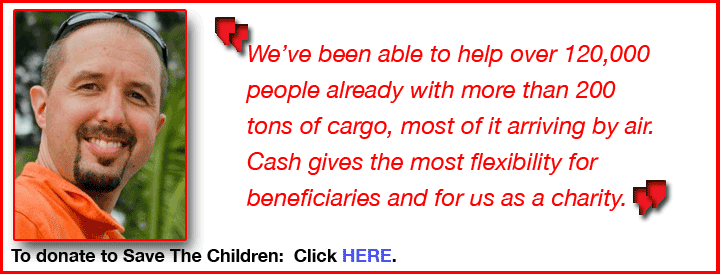
Discussing a client's needs over a cup of tea.
(Nepal Exclusive)—Like
many of the people working on the relief effort in Nepal, Steve Wells
is an ordinary guy doing his best in exceptional circumstances.
The 43-year-old from Baltimore, Maryland,
is organizing the logistics of getting aid into Nepal for Save
the Children (STC) in his capacity as the charity’s
Head of Logistics. He draws on the vast experience gained in previous
positions with the International Organization for Migration in Sri Lanka,
Pakistan, and Thailand, and, before that, Nissan Motor Corporation.
As many other NGOs also report, one of the
main challenges in Nepal is the lack of landing slots at KTM. “There
are only nine stands at KTM and one runway, so when the airport is full,
it’s full,” he told FlyingTypers. “If the agencies don’t
clear the cargo then it’s blocked up and that leaves planes circling
before landing, which in turn means we can load less cargo as we need
more fuel.”
STC is bringing in relief from around the
world as well as sourcing in India and has now flown in more than 35 freighters,
sometimes entirely on its own account, and sometimes with capacity shared
with other NGOs.

“We have brought a lot of relief aid
in from China, where we have a major donor we work with closely through
our Chinese office called One Foundation. This has been children’s
sleeping bags, large tents, and tarpaulins,” he said. “We’ve
also brought in a lot of hygiene kits from India by truck and there are
more on the way. For the most part, except for securing landing slots,
getting clearances from Nepali customs hasn’t been too time consuming.”
STC has been able to ramp up its operations
in Nepal via an existing aid program. “We already had a good base
here,” said Wells. “We have contracts for trucking fleets,
warehouses, and remote field offices in places so we can get aid out into
the field quickly. In some places this might include using 4x4s or even
donkeys to reach the most vulnerable people.
“We’ve been able to help over
120,000 people already with more than 200 tons of cargo, most of it arriving
by air.
“But the situation is changing very
quickly. Every time there is another quake, that means more landslides,
so one day you can reach people, the next day you can’t, and sometimes
the distribution teams get stuck in the field for days until the road
is passable.”
“We have a lot more aid coming in
our pipeline—at least enough to ensure 50,000 households will be
able to survive the monsoon season.”
STC is also mindful of distorting local
markets, often a problem during any disaster response. “We are doing
local procurement, but it’s a delicate balancing act. If you purchase
in Nepal you can drive the prices up, but if you only bring everything
from outside then you can also flood the market here, so we watch markets
very closely.”
With the monsoon looming, STC is also working
with villagers to develop building techniques for the short and long-term.
“In the short-term people need shelter for the next few months,
but in the long-term they need safe housing. They usually don’t
build with timber but instead use mud and stone. So we’re looking
at what building techniques can protect against future quakes better than
mud and stone.
“But at this stage NGOs and the various
militaries are still identifying where a lot of people in need are, and
then trying to get tractors and porters to them with aid.
“The monsoon season is very much on
our radar because everything will soon get harder to do and people will
be more at risk.
“As much as anything this is a logistical
humanitarian crisis. The people most affected are in high altitudes and
they are hard to reach even with choppers. And then the payload you can
take is tiny. We’re doing the best we can to reach them. But I think
this definitely could get worse because of the obvious bottlenecks involved
in getting aid in and reaching the most vulnerable people.
“Cash is the best way of helping here,
because lots of things can be sourced locally, which boosts markets if
it’s not overdone. When relief is sent over by itself, by well-meaning
people, it just adds to the logistical difficulties.”
“Cash gives the most flexibility for
beneficiaries and for us as a charity.”
SkyKing
SkyKing is also working with
a charity to raise USD $50,000 for Nepal humanitarian efforts. This will
be enough to feed and provide shelter through the monsoon season for almost
600 families in Sindhupalchowk, many of whom have been left homeless.
If you would like to donate, please click here.
|





